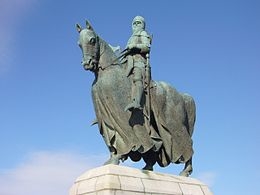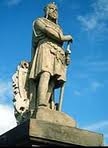
The battle of Bannockburn, like that of Stirling Bridge (and for the same reason), holds a hugely important place in the collective memory of Scotland: for the second time in a generation the underdogs triumphed against the might of an imperialist English military machine.
Battle of Bannockburn, 1314.
The decisive battle in the Wars of Independence resulted from an agreement between Philip de Mowbray (the Scottish knight with whom the English king Edward II had entrusted the custody of Stirling Castle) and Edward Bruce (with whom his brother Robert I had entrusted the siege of the castle) that de Mowbray would surrender if he had not been relieved by midsummer. This forced Edward II to march northward and Robert I to prepare for a set battle.
Edward raised some 16,000 infantry, 2500 mounted knights, and a 20-mile supply train; on 22 June all these marched 22 miles from Edinburgh to Falkirk. Robert the Bruce raised about 6000 spearmen, a few archers and 500 light horse.
One of the most memorable episodes in Scottish history now occurred. Henry de Bohun, nephew of the Earl of Hereford, was riding ahead of his companions when he caught sight of the Scottish king. De Bohun lowered his lance and began a charge that carried him to lasting fame. King Robert was mounted on a small palfrey and armed only with a battle-axe. He had no armour on. As de Bohun's great war-horse thundered towards him, he stood his ground, watched with mounting anxiety by his own army. With the Englishman only feet away, Bruce turned aside, stood in his stirrups and hit the knight so hard with his axe that he split his helmet and head in two. This small incident became in a larger sense a symbol of the war itself: the one side heavily armed but lacking agility; the other highly mobile and open to opportunity. Rebuked by his commanders for the enormous risk he had taken, the king only expressed regret that he had broken the shaft of his axe.

Bruce was outnumbered three to one, but he had chosen his ground carefully. His army, with only a handful of light cavalry and no archers to match the English, was drawn up on higher ground than his opponents. The heavily armoured English knights thus found themselves forced to advance through the waterlogged meadows which bordered the Bannock Burn which was a deep, wet marsh, while the English archers, for their part, had no room to deploy.
The battle (23-24 June) is recounted in great detail by chroniclers. The English cavalry charged to open the road, almost captured Robert, and were driven back with heavy losses; another column was broken by Thomas Randolph's spearmen near St Ninians.
After a night of scant rest the battle resumed at sunrise. The cavalry again charged against the Scots who were drawn up in four battails (Randolph, James Douglas and Walter Stewart, Edward Bruce, and Robert himself) formed into flexible squares of spearmen called schiltrons. The English infantry could not deploy on the narrow front, and all were driven back into the Bannock Burn with terrible results.
Edward and 500 of his knights reached Stirling Castle, but Mowbray refused them admission and surrender was imminent.
Consequently, Edward fled towards Dunbar. Knowing that their king had deserted them left the English army with little fighting spirit. Suddenly there appeared the sma’ folk, the gillies or camp followers, banging on their pots and pans. To the battle-weary eyes of the English, this looked like a wild attack by fresh Scottish troops. The English right flank tried to follow their King from the field, their centre headed for the waters of the Forth, and their left fell back into the Bannock Burn.
The English were in full flight and their King was making for Dunbar and the border as fast as his horse could carry him.

The site of the battle, or part of it, is now vested in the National Trust for Scotland on behalf of the Scottish nation. A rotunda, an equestrian statue of Robert I and the heritage centre stand where the remains of a borestone mark Robert's command post.
